Phil Licciardi and the Morane Saulnier Al
Prose: Nicholas Pascarella
Photography: Chris Rose
In 2018, more than 100 years after its initial production, I found myself near the pieces of a Morane-Saulnier AI in the Fighter Factory building at the Military Aviation Museum (MAM) in Pungo, Virginia. I was shooting the run-up of the MAM's de Havilland Mosquito through the windows of the hangar, looking for the perfect shot when Phil Licciardi walked through my frame. He realized what I was doing and poked his head around the door to offer escort inside the hangar for the duration of the run-up, and afterwards we began talking about the project at our feet.
As one of the fastest aircraft of World War I, the Morane-Saulnier AI was a French high parasol-wing design. The wings had a slight sweep which allowed the aircraft a relatively high top speed for the era of 140mph. The design intended to replace the Nieuport 17 and the SPAD VII in French service, but was relegated to an advanced trainer with the coming of the SPAD XIII in mid-1918. Only a few survive today.
The frame and assorted pieces in front of us assumed the shape of this rare design. As is usual with these things, time got short quickly and I had to leave without inquiring about the details of this project. Luckily, Full Disc Aviation photographer Chris Rose lives near MAM. He went back to the Fighter Factory and spent some time with Phil looking over his recent work on the airframe and catching up with Phil on his aviation life, including its humble beginnings.
"When I first got into aviation it was because of my uncle," Phil recalls. "He lives here and I'm from Long Island..now there was a guy Vinny whose dad died over in Iraq and he was doing a charity event on Long Island, so they all shot up there and his motorcycle broke in New Jersey. So I gave my uncle a ride to his buddy's house and at his buddy's house he was building a little Pitts, I think it was a Pitts, in his garage, and I was like 'That thing is sweet!'
Phil's uncle, who does AC work, needed a ride back home to Virginia Beach, "and lo and behold, one of [Jerry Yagen's] schools had a broken AC, so he had a contract to go there and do the maintenance on it. And I walk in there and start talking to Brad Groom, he was the director at the time, big handlebar mustache, and I grilled him with the hardest questions you could imagine. And I felt like he was crying when I left the room. It was bad. But I was like, you know what, if I'm gunna spend that kinda cash on A&P [Airframe and Powerplant Certification] I need to figure out if it's gunna be good or not."
Two days later he was signing the paperwork; he completed all of school there at Centura College. "While I was there, I didn't even know this place [MAM or the Fighter Factory] existed...didn't know anything about it, didn't do any research of even what was in this area," Phil reflected. "I found out about it by this little tiny poster on the wall that was there [at school].. 'what's this, I can work there?' So, then I talked to my uncle about it; my uncle knows the guy who use to own Suffolk Skydive when the Fighter Factory was over there..." Through his uncle once more, they met with Thomas Kurtz, general manager of the Fighter Factory, ["TK"] and thus began his time at the Fighter Factory.
"I was there [at MAM] for pretty much the remainder of school. After that, I jumped ship and went to work for the airlines and discovered unions and all the different side effects and pros and cons...and decided that wasn't for me. So then TK called me up 'cuz he knew they were closing that maintenance base, and then I just started back right into this project."
Jerry Yagen, the president of the Aviation Institute of Maintenance and owner/president of the Military Aviation Museum, had an incentive to supply tools to encourage students at each campus to build aircraft. This Morane started life at the Kansas City campus in the hands of the students there. During assembly, popping and snapping was heard within the wing. The wing needed a complete rebuild. "Wood is an interesting material to work with," Phil mused.
"The first thing I did when I walked in was; [I] redid the rudder bar, and we were gunna hang the wing..." with one of the other apprentices, but working together, they ran into a few snags and had to repeat a few steps. He acknowledges working with apprentices is challenging, but sharing of information is invaluable in this type of work. Being new and unaware of certain procedures or techniques causes a good bit of growing pains. Typical of how projects like these progress; two steps forward, one step back.
"The wing is an interesting design," Phil notes. He points out that most wings are flatter on the bottom than the top, but the bottom of this wing has a similar camber to the top. This makes shrinking the fabric around the ribs a "detailed, skillful, time-consuming, 40 cuss-word job." Like a taut rope, the fabric looks for and curls around the highest points. Without those points, it flattens out due to the tension. Molding the fabric to the camber on the underside of the wing then becomes extremely challenging. The fabric is shrunk to half its tightness, Phil explained, then the ribs are stitched, and finally the fabric is tightened to its proper tension. Paint and reassembly follow.
Phil started this project with a man named Gary Garnes, who died tragically of pancreatic cancer. Before leaving this project for Phil to complete, Gary cut out all of the ribs and many of the fine detail gussets. He also completed about 70% of one wing working with Al Lintz, the shop supervisor. Phil mentioned that Gary's other project was a Nieuport 24; that one is next on the rebuild list.
"The only thing that was reused on this wing was the brackets that are mounted on the wing, and the spars...and then once we mounted it on the actual airframe, every single one of those struts, there's like, 32 attachment points per side, plus all the cables, it's insane...every one of those had to be remade. So I sliced the ends, fish mounted everything, tacked it up and it all went off to a welder. It was quite the project."
This work of stretching and heat treating fabric, mounting ribs and stringing wires comes with its own stressors, but the novel nature of the work overrides the stress of such tedious labor. That said, referring to the unused scraps collected in a big pile in the hangar; "We're gunna burn it. Big bonfire out back," Phil vented.
The next step for the project after all the repetitive work of stitching and taping is painting. After that, it's test flights and getting a pilot comfortable behind the controls. "It's a very rare plane to fly, so finding a pilot that has flown one is rarer than the plane. But not to worry about that, the pilots have an incredible background in flying odd, old, and strange planes, I know a match will be made," Phil offered. The end goal is to have the plane fly in the October airshow. "The biggest fear that I have is bad weather. I don't want to see it get rained out after all the hard work."
Neither do we, but the thrill when she flies for the first time will be complete. The countless hours spent cutting, stitching, wrenching, taping and testing feel immensely heavy until the engine fires for the first flight. The prop will burst into animation, the aircraft will taxi out and blast down the grass strip at the Military Aviation Museum, lifting the weight of all those hours of work into the air, soaring above the treetops and around the stark orange and white water tower on the grounds. And we can't wait.
"Another interesting thing about this whole aviation thing," Phil notes, "it's how I met my wife. We did our engagement photos in front of Wild Cargo (the MAM's B-25) 'cuz for some reason that's where she fell in love with me, literally in the bomb bay, she just started kissin' me."
Isn't that what all this is about anyway? Love? Love for historical aircraft, love for the poetry of flight, love for one another?
[editor's note: the answer is yes.]

















